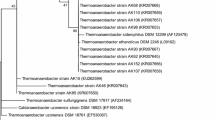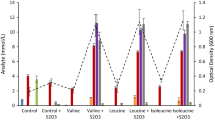Summary
Statistically designed experiments were used to identify variables important in the 7α-dehydroxylation of cholic acid to deoxycholic acid by strains of Clostridium bifermentans in pH-controlled anaerobic fermentation. Deoxycholic acid yields were highest in the presence of 10% CO2 and near pH 7 but were largely unaffected by the strain of organism used, time of bile acid substrate addition, mode of gas delivery, presence of thioglycollate, or the use of OH− ion or HCO −3 ion for pH control. However, dehydroxylation was enhanced, and the redox potential remained relatively high, when temperatures were low, inoculum size small, and growth inhibitors were present.
Deoxycholic acid yields of up to 40% were observed but the formation of 7-ketodeoxycholic acid side product could not be entirely prevented.
Similar content being viewed by others
References
Aries V, Hill MJ (1970) Degradation of steroids by intestinal bacteria, I, Deconjugation of bile salts. Biochim Biophys Acta 202:535–543
Bokkenheuser VB, Winter J, Dehazya P, Kelly WG (1977) Isolation and characterization of human fecal bacteria capable of 21-dehydroxylating corticoids. Appl Environ Microbiol 34:571–575
Box GEP, Hunter JS (1961) The 2k-p factorial designs, Part I. Technometrics 3:311–351
Chen CH (1976) A mild dehydromesylation reaction in the synthesis of methyl 3,7-diacetylchol-11-enate. Synthesis 125–126
Daniel C (1959) Use of half-normal plots in interpreting factorial two-level experiments. Technometrics 1:311–341
Drasar BS, Hill MJ (1974) Human Intestinal Flora. Academic Press, San Francisco London New York
Ferrari A, Cocucci MC (1967) Transformazione in vitro dell' acido colico ad acido desossicolico ad opera di micro-organismi intestinali. Atti XIV Congr Soc Ital Microbiol Oct 1967, 205–209
Ferrari A, Scolastico C, Beretta L (1977) On the mechanism of cholic acid 7α-dehydroxylation by a Clostridium bifermentans cell-free extract. FEBS Lett 75:166–168
Fieser LF, Rajagopalan S (1949) Selective oxidation with N-bromosuccinimide, I, Cholic acid. J Am Chem Soc 71:3935–3958
Garland RP (1977) New Zealand Pharmaceuticals Ltd, private communication
Gustafsson BE, Midvedt T, Norman A (1966) Isolated fecal microorganisms capable of 7α-dehydroxylating bile acids. J Exp Med 123:413–432
Hattori T, Hayakawa S (1969) Isolation and characterisation of a bacterium capable of 7α-dehydroxylating cholic acid from human faeces. Microbios 3:287–294
Hayakawa S, Hattori T (1970) 7α-Dehydroxylation of cholic acid by Clostridium bifermentans strain ATCC 9714 and Clostridium sordellii strain NCIB 6929. FEBS Lett 6:131–133
Hill, MJ, Drasar BS (1968) Degradation of bile salts by human intestinal bacteria. Gut 9:22–27
Hoehn WM, Linsk J (1945) 3,12-Dihydroxy-7-ketocholanicacid. J Am Chem Soc 67:312–314
Macdonald IA, Webb GR, Mahoney DE (1978) Fecal hydroxysteroid dehydrogenase activities in vegetarian Seventh Day Adventists, control subject and bowel cancer patients. Am J Clin Nutr 31:S233-S238
Maddox IS, Chong R (1978) Hydrolysis of glycocholic acid by fungi. Eur J Appl Microbiol Biotechnol 5:241–245
Midtvedt T, Norman A (1968) Parameters in 7α-dehydroxylation of bile acids by anaerobic lactobacilli. Acta Pathol Microbiol Scand 72:313–329
Nakada F (1963) Dehydration of bile acids and their derivatives, XII, chol-3,7,11-trienic acid and its partially hydrogenated compounds — A note on α-cholatrienic acid II. Steroids 2:45–59
Portman OW, Shah S, Antonis A, Jorgensen B (1962) Alteration of bile salts by bacteria. Proc Soc Exp Biol Med 109:959–965
Samuel P, Holtzman CM, Meilman E, Sekowski I (1973) Effect of Neomycin and other antibiotics on serum cholesterol levels and on 7-dehydroxylation of bile acids by the faecal bacterial flora in Man. Circ Res 33:393–402
Sjövall J (1964) Separation and determination of bile acids. In: Glick D (ed) Methods of biochemical analysis, vol. 12. Wiley (Interscience), New York, pp 97–141
Stellwag EJ, Hylemon PB (1978) Characterization of 7α-dehydroxylase in Clostridium leptum. Am J Clin Nutr 31:S243-S247
Tserng K-Y, Klein PD (1977) Formylated bile acids: Improved synthesis, properties and partial deformylation. Steroids 29:635–648
Author information
Authors and Affiliations
Rights and permissions
About this article
Cite this article
Archer, R.H., Maddox, I.S. & Chong, R. 7 α-Dehydroxylation of cholic acid by Clostridium bifermentans . European J. Appl. Microbiol. Biotechnol. 12, 46–52 (1981). https://doi.org/10.1007/BF00508118
Received:
Issue Date:
DOI: https://doi.org/10.1007/BF00508118




